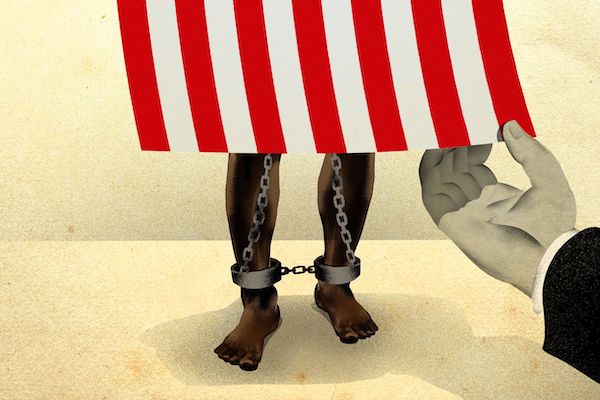Germany faced its horrible past. Can America do the same?

Michele L. Norris in an essay for the Washington Post:
One of the participants had recently toured the museum and had a pointed question. Why, she wondered, were all the exhibits that visitors first encounter dedicated to slavery? […] She suggested that the museum should instead usher visitors toward more positive stories right from the start, so that if someone were tired or short on time, “slavery could be optional.”
Her question was irksome, but it did not surprise me. I’d heard versions of the “Can’t we skip past slavery” question countless times before. Each time serves as another reminder that America has never had a comprehensive and widely embraced national examination of slavery and its lasting impact.
Germany has a dark past as well, one of the darkest, however over the past several decades it’s shown how a nation can begin to set things right.
In today’s Germany, children learn through their teachers and textbooks that the Nazi reign was a horrible and shameful chapter in the nation’s past. Cadets training to become police officers in Berlin take 2½ years of training that includes Holocaust history and a field trip to the Sachsenhausen concentration camp. With a few exceptions for the sake of education, it is against the law to produce, distribute or display any symbol of the Nazi era, including the swastika, the Nazi flag and the Hitler salute. It is also illegal to deny that the Holocaust was real.
The Racial Reckoning That Wasn’t
NPR’s Code Switch hosts Gene Demby and Shereen Marisol Meraji speak with researchers about the huge increase in white support for racial justice and its subsequent (inevitable?) collapse.
The conversation centers on findings the researchers, political scientists Jennifer Chudy and Hakeem Jefferson, revealed in an essay for the New York Times.
DEMBY: When it comes to white people who care about anti-Black racism at all…
CHUDY: They are a tiny, tiny, tiny, tiny, tiny percentage of the population.
DEMBY: What does that mean? Like, tiny percentage? Like, how tiny are we talking?
The answer is disheartening. (Chudy follows it up with a hilarious Malcolm X quote that shows he already knew the score.)
So, there was a tiny number of supporters before the events of last year, before the surge. As that number began taking off in spring, Chudy says she knew it could never hold up.
The Kardashians Leave a Legacy of Blackfishing and Appropriation
Cady Lang, writing for Time:
“They’ve been called out for cultural appropriation for a decade plus now, and it’s no secret that they’ve adopted many styles that Black women or Black culture have created and made them more palatable,” Wanna Thompson says, recollecting when Kim wore cornrows and beauty writers dubbed them “boxer braids,” rebranding the longtime protective style worn by Black women as a trend inspired by boxers. “Now people think they’re copying the Kardashian-Jenners when they dress or do their hair or tan their skin a certain way.”
I hadn’t heard the term Blackfishing before. Here’s what it means:
Perhaps it should come as no surprise that the term Blackfishing (a portmanteau of Black and catfishing that describes a step beyond cultural appropriation, when people alter their appearance with makeup, cosmetic surgery, filters or digital editing to appear Black) originated on social media in 2018, well into the reign of the Kardashian-Jenners’ popularity. Wanna Thompson, the journalist who coined the term while elaborating on the phenomenon in a viral Twitter thread of “white girls cosplaying as Black women” that featured endless Kardashian-Jenner simulacrum, says that the sisters, who have been criticized for acts like claiming that they “started wigs” to wearing grills, have played a significant role in normalizing or even popularizing Blackfishing with images of themselves projecting racial ambiguity.
Hollywood’s Black Snitches Aren’t Telling the Whole Story

Jordan McDonald for Vulture:
By treating the informant as a stand-in for the state, these films don’t offer new insights into state violence or the vulnerabilities it must foster to secure its informant class. Rather, they flatten both their revolutionary heroes and their counterrevolutionary villains. It’s a narrative betrayal of both the Black informant and their Black victims.
In One Modest Cotton Sack, a Remarkable Story of Slavery, Suffering, Love and Survival
Historian and Harvard professsor Tiya Miles’s new book All That She Carried focuses on a cotton sack from the mid-1800s an enslaved woman gave to her daughter Ashley. Jennifer Szalai reviews the book for the Times.
From 2016 until earlier this year, the artifact now known as Ashley’s sack had been on display at the Smithsonian’s National Museum of African American History and Culture; it was on loan from Middleton Place in South Carolina, where so many viewers started weeping when they saw it that curators handed out tissues beside its display.
How ‘Lupin’ Star Omar Sy Became An International TV Sensation

Alexandra Marshall profiles Sy for Vogue:
“My sense of adventure comes from the place I grew up,” says Omar Sy, the star of Lupin—the Netflix series that has become an international phenomenon—and easily the most beloved actor in France. (Three times Sy has been voted France’s favorite person, on an open ballot.)
Lupin returns tonight.
5 Routines Proving Simone Biles Is the 🐐
24-years-old and hasn’t lost in 8 years.
‘You’re a low wage worker, right?’
An economics lesson from the Krusty Krab.
Thanks for reading. See you next week.
